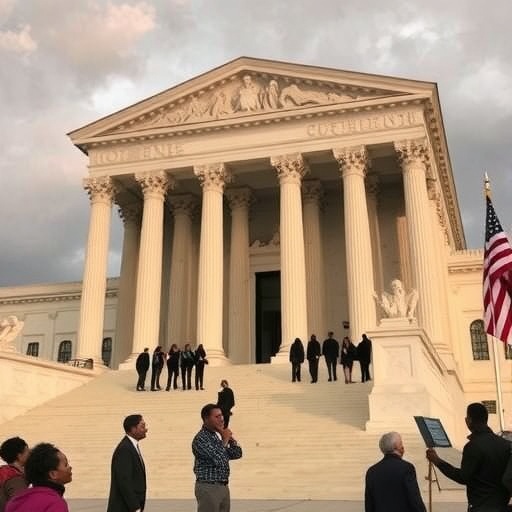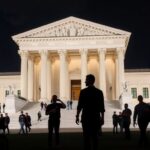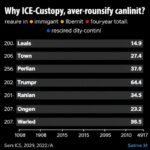Supreme Court Scrutinizes Voting Rights Act Section 2, Endangering Minority Representation in Redistricting Battles
In a move that could reshape the landscape of American democracy, the U.S. Supreme Court is delving into the heart of the Voting Rights Act, with oral arguments revealing deep divisions over Section 2’s role in combating racial discrimination during redistricting. This pivotal provision, long hailed as a bulwark against vote dilution, now faces potential invalidation, threatening minority representation in congressional and local elections across the nation. As justices grilled attorneys on both sides last week, the stakes couldn’t be higher: a ruling against Section 2 could unleash a wave of gerrymandered maps that sideline Black, Latino, and other minority voters, echoing the darkest chapters of voting suppression history.
The case at hand, Merrill v. Milligan—stemming from Alabama’s controversial congressional map—has thrust the Supreme Court back into the fray of voting rights litigation. Challengers argue that Section 2 imposes an undue burden on states’ redistricting autonomy, while defenders warn that gutting it would dismantle decades of progress in ensuring fair elections. With the 2024 cycle looming, this decision isn’t just legal jargon; it’s a potential earthquake for minority representation, where communities of color could see their voices drowned out in districts engineered to favor one party.
Section 2’s Battle-Tested Legacy in Protecting Minority Voters
Enacted in 1965 amid the Civil Rights Movement’s fervor, the Voting Rights Act was President Lyndon B. Johnson’s signature legislation to shatter Jim Crow-era barriers. Section 2, in particular, stands as the Act’s enduring sword against racial gerrymandering, prohibiting any voting practice that dilutes the electoral strength of protected minorities. Unlike the now-defunct Section 5, which required federal preclearance for changes in covered jurisdictions—a provision struck down in the 2013 Shelby County v. Holder ruling—Section 2 applies nationwide and demands proof of discriminatory intent or effect.
Over the years, Section 2 has been a lifeline for minority representation. Consider the 1982 amendments, spurred by a Supreme Court decision that nearly neutered the provision; Congress responded by clarifying that plaintiffs need only show discriminatory results, not intent, making enforcement more accessible. Statistics underscore its impact: According to the Brennan Center for Justice, Section 2 challenges have led to the redrawing of over 100 districts since 1980, boosting Black and Latino congressional seats by nearly 20% in key states like Georgia and Texas.
One landmark example is the 2013 Alabama Legislative Black Caucus v. Alabama case, where the Court upheld Section 2’s use to strike down maps that packed Black voters into a single district, diluting their influence elsewhere. “Section 2 is the last firewall against the return of poll taxes and literacy tests by another name,” said civil rights attorney Michelle Anderson in a recent interview. Without it, redistricting processes—often controlled by state legislatures—could revert to packing and cracking tactics that fracture minority voting power.
Yet, critics like Alabama’s Solicitor General Edmund LaCour argue during oral arguments that the provision has evolved into a tool for partisan warfare. “Requiring states to draw ‘majority-minority’ districts in every instance where possible turns redistricting into a racial quota system,” LaCour contended, citing data from the U.S. Census Bureau showing that such mandates could force unnatural district shapes, ignoring community interests beyond race.
Alabama’s Redistricting Flashpoint Ignites National Debate
At the epicenter of this Supreme Court showdown is Alabama’s 2021 redistricting saga. After the 2020 Census revealed Black residents comprise 27% of the state’s population—enough for a second majority-minority congressional district—the state’s Republican-led legislature drew maps preserving seven white-majority districts out of seven. Plaintiffs, including the ACLU and Black voters, sued under Section 2, arguing the plan diluted Black voting strength in violation of the Voting Rights Act.
A federal three-judge panel agreed, ordering a redraw to include two districts where Black voters could form effective majorities. But the Supreme Court intervened, staying the decision and allowing the original maps for the 2022 midterms. This interim victory for Alabama has emboldened similar challenges in states like Louisiana and Georgia, where minority representation hangs in the balance. In Louisiana, for instance, a Section 2 suit seeks to expand Black congressional seats from one to two, potentially flipping the state’s delegation in future elections.
During oral arguments on October 4, 2023, Justice Elena Kagan pressed Alabama’s counsel: “If Section 2 doesn’t require race-conscious redistricting to remedy dilution, what tool do minorities have left?” The exchange highlighted the provision’s complexity—balancing anti-discrimination with the Equal Protection Clause’s colorblind ideal. Justice Clarence Thomas, a longtime skeptic, suggested Section 2 might unconstitutionally compel racial gerrymanders, drawing parallels to the Court’s 2022 Students for Fair Admissions v. Harvard ruling against affirmative action.
Expert analysis from the Voting Rights Lab at NYU estimates that upholding the lower court’s ruling could add 10-15 minority-held seats nationwide by 2030, based on demographic shifts. Conversely, striking down or narrowing Section 2 could entrench Republican advantages in the House, where gerrymandering already costs Democrats up to 10 seats, per Princeton Gerrymandering Project data.
Civil Rights Advocates Rally Against Erosion of Voting Protections
The chorus of concern from civil rights groups is deafening as the Supreme Court weighs this case. The NAACP Legal Defense Fund, lead plaintiff in Merrill v. Milligan, has mobilized a coalition of over 50 organizations, filing amicus briefs that paint a dire picture. “Striking Section 2 would be Shelby County on steroids,” warned Sherrilyn Ifill, former LDF president, in a statement to reporters. “It would greenlight a new era of voter suppression, where minority representation becomes an afterthought in elections.”
Grassroots voices echo this alarm. In Selma, Alabama—birthplace of the Bloody Sunday march—local activist John Lewis Jr. (no relation to the late congressman) shared stories of intergenerational disenfranchisement. “My father fought for the Voting Rights Act; now, they’re trying to undo it. Black voters here are 30% of the population but only one safe district— that’s not representation, that’s marginalization,” he told a CNN affiliate.
Statistics bolster these pleas: The U.S. Commission on Civil Rights reports that post-Shelby County, Section 2 lawsuits surged by 40%, compensating for lost preclearance. In 2022 alone, challenges under the provision blocked discriminatory maps in five states, preserving minority representation in local races like school boards and city councils, where turnout disparities hit 15-20% for people of color, per Pew Research.
Even some conservative scholars, like election law expert Rick Hasen, have cautioned against overreach. In a Washington Post op-ed, Hasen wrote, “While redistricting reform is needed, eviscerating Section 2 invites chaos. States would race to the bottom, drawing maps that exacerbate racial polarization in elections.” Bipartisan support flickers too; a group of former Republican attorneys general filed a brief urging the Court to preserve the provision’s core.
Broader Ramifications: From Congress to Statehouses
Beyond congressional lines, the fate of Section 2 reverberates through every level of governance. Local elections—for city councils, state legislatures, and even judges—rely on the provision to prevent packing minorities into unwieldy districts. In Texas, a 2021 Section 2 victory redrew Senate maps, increasing Latino influence in border counties where they form 60% of the population but held only 20% of seats pre-litigation.
Demographic trends amplify the urgency. The Census Bureau projects that by 2045, people of color will be the U.S. majority, yet without robust safeguards, redistricting could lock in white-majority power. A 2023 report from the National Conference of State Legislatures notes that 36 states use partisan processes for drawing maps, ripe for abuse absent federal oversight like Section 2.
Internationally, the case draws scrutiny; the U.N. Human Rights Committee has cited U.S. voting disparities in reviews, urging stronger protections. Domestically, fallout could spur legislation: Democrats in Congress have reintroduced the John Lewis Voting Rights Advancement Act, which would restore preclearance elements, though passage remains elusive in a divided Senate.
Legal watchers predict a 5-4 or 6-3 decision by June 2024, with Chief Justice John Roberts potentially authoring a compromise narrowing—but not eliminating—Section 2’s reach. Justice Brett Kavanaugh’s questions suggested openness to race-neutral alternatives, like statewide proportionality requirements, though such ideas face constitutional hurdles.
Looking Ahead: Safeguarding Democracy in a Divided Nation
As the Supreme Court deliberates, the path forward demands vigilance. States like Michigan and Ohio, fresh from citizen-led redistricting reforms, offer models of independence, but most lack such mechanisms. Advocacy groups are already gearing up for post-ruling battles, training litigators and mobilizing voters through initiatives like the Fair Maps Campaign, which registered 500,000 new minority voters in battleground states last year.
The implications for 2024 elections are profound: A weakened Voting Rights Act could suppress turnout in key demographics, tilting scales in swing districts. Yet, history shows resilience; the 1965 Act passed after Selma’s horrors, and today’s fights—from Georgia’s 2021 protests to Arizona’s ballot measures—signal a renewed push for equity.
Ultimately, preserving minority representation isn’t just about maps; it’s about ensuring every voice shapes the nation’s future. As the gavel falls, the Supreme Court holds the power to fortify or fracture that promise, leaving Americans to wonder if democracy’s guardrails will hold against the tide of division.










